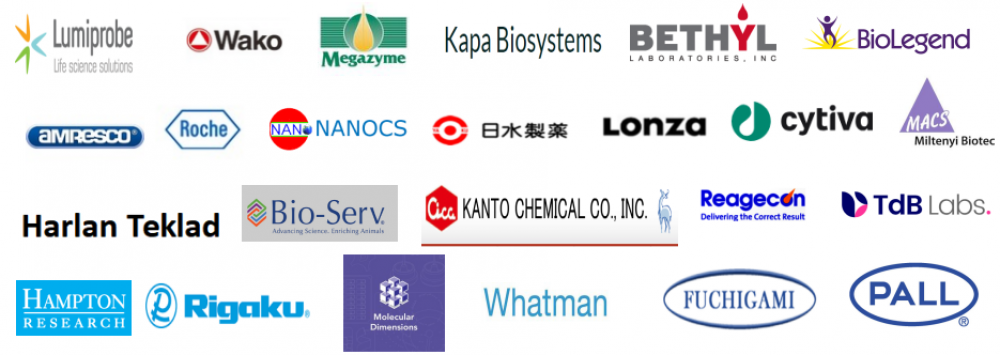Oxoid CM0868B 叠氮葡萄糖肉汤(罗泰肉汤) AZIDE DEXTROSE BROTH (ROTHE)
【简单介绍】
用于检测水、污水和食品中的肠球菌
【详细说明】
叠氮葡萄糖肉汤(罗泰肉汤)500g可以配制
14.0升培养基
CMO868B 1,337.00Azide Dextrose Broth(Rothe Broth)用于检测水、污水和食品中的肠球菌
Dehydrated Culture Media
AZIDE DEXTROSE BROTH (ROTHE)
Code: CM0868
For the detection of enterococci in water
用于检测水中的肠球菌
| Typical Formula* |
gm/litre |
| Peptone |
20.0 |
| Glucose |
5.0 |
| Sodium chloride |
5.0 |
| Di-potassium hydrogen phosphate |
2.7 |
| Potassium dihydrogen phosphate |
2.7 |
| Sodium azide |
0.2 |
| Final pH 6.8 ± 0.2 @ 25°C |
* Adjusted as required to meet performance standards
Direction
Add 35.6g to one litre of distilled water for single strength broth or 71.2g for double strength broth. Heat gently to dissolve. Dispense into final containers and sterilise by autoclaving at 121°C for 15 minutes.
Description
Azide Dextrose Broth (Rothe) is used for the detection of enterococci in water and sewage1.
The presence of enterococci serves as an indicator of faecal contamination. Enterococci are better indicators than Escherichia coli of sewage pollution in chlorinated waters because they have a greater resistance to chlorine.
Mallmann and Seligmann2 recommended Azide Dextrose Broth for the quantitative determination of enterococci in water, sewage, foods and other materials suspected of contamination with sewage.
A blend of peptone and glucose render Azide Dextrose Broth highly nutritious, and sodium chloride maintains osmotic equilibrium. The use of sodium azide as an inhibitor of Gram-negative organisms has been reported by several workers2,3,4, and the concentration selected provides optimum protection for the enterococci while largely suppressing the Gram-negative flora. The phosphate buffer system controls pH.
Technique
Inoculate 10ml of medium with 1ml of the test sample. Inoculate a further three tubes with 0.1ml, 0.01ml and 0.001ml sample respectively. For samples of 10ml or more, use double strength broth. Incubate all tubes at 35°C and examine for turbidity after 24 and 48 hours. For a more detailed description please consult `Standard Methods for the Examination of Water and Wastewater’.
The presence of enterococci in the sample is indicated by turbidity in the broth.
Storage conditions and Shelf life
Store the dehydrated medium at 10-30°C and use before the expiry date on the label.
Store the prepared medium at 2-8°C.
Appearance
Dehydrated medium: Straw coloured, free-flowing powder
Prepared medium: Straw coloured solution
方向
将 35.6 克添加到一升蒸馏水中制成单浓度肉汤或 71.2 克添加双浓度肉汤。轻轻加热溶解。分装到最终容器中并在 121°C 高压灭菌 15 分钟进行灭菌。
描述
叠氮化物葡萄糖肉汤 (Rothe) 用于检测水和污水中的肠球菌1。
肠球菌的存在可作为粪便污染的指标。肠球菌比大肠杆菌更好地指示氯化水中的污水污染,因为它们对氯的抵抗力更强。
Mallmann 和 Seligmann2 推荐使用叠氮化物葡萄糖肉汤定量测定水、污水、食品和其他疑似污水污染的材料中的肠球菌。
蛋白胨和葡萄糖的混合物使叠氮化物葡萄糖肉汤营养丰富,氯化钠保持渗透平衡。一些工作人员已经报道了使用叠氮化钠作为革兰氏阴性菌的抑制剂2、3、4,所选浓度为肠球菌提供了最佳保护,同时在很大程度上抑制了革兰氏阴性菌群。磷酸盐缓冲系统控制 pH。
技术
用 1ml 测试样品接种 10ml 培养基。分别用 0.1ml、0.01ml 和 0.001ml 样品接种另外三个试管。对于 10 毫升或更多的样品,使用双倍浓度肉汤。在 35°C 下孵育所有试管,并在 24 和 48 小时后检查混浊度。有关更详细的说明,请参阅“水和废水检查的标准方法”。
肉汤中的混浊度表明样品中存在肠球菌。
储存条件和保质期
将脱水培养基储存在 10-30°C 并在标签上的有效期之前使用。
将准备好的培养基储存在 2-8°C。
外貌
脱水介质:稻草色、自由流动的粉末
制备培养基:稻草色溶液
Quality control
| Positive control: | Expected results |
| Enterococcus faecalis ATCC® 29212* | Turbid growth |
| Negative control: | |
| Escherichia coli ATCC® 25922 * | No growth |
* This organism is available as a Culti-Loop®
Precautions
This product contains less than 1% azide and has low toxicity. However, when handling the powder, wear gloves, mask and eye protection. When washing azide products down sinks, use sufficient water to prevent accumulation of azide in the plumbing.
References 参考文献
1. Greenberg A. E. et al (ed). (1998) Standard Methods for the Examination of Water and Wastewater, 20th ed. APHA, Washington, D.C.
2. Mallmann W. L. and Seligmann E. B. (1950) Am. J. Public Health 40. 286.
3. Edwards S. J. (1933) J. Comp. Path. Therap. 46. 211.
4. Hartman G. (1937) Milchw. Forsch. 18. 166.
